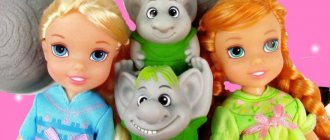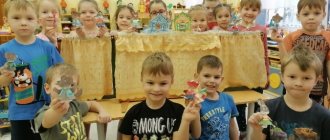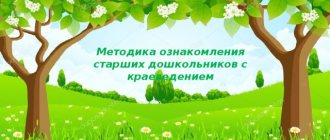Project “My Favorite Toy”
Project information card:
Project type: creative, group.
Project duration: short-term (2 weeks).
Project participants: children, teachers, parents.
Children's age: 2-3 years.
Relevance of the problem : The most important components of the educational environment are games and toys. Toys for a child are the “environment” that allows them to explore the world around them, develop and realize creative abilities, and express feelings; toys teach you to communicate and get to know yourself. Selecting toys is a serious and responsible matter. The child’s mood and progress in his development depend on the successful solution of this problem. Sometimes adults get upset, even angry at the child for not using the toys, not suspecting that he simply does not know how to play with all this. Toys themselves will not mean anything to a child if he does not know how and what to play with them.
Problem: At this age, children use many toys for other purposes and do not know how to play with them.
Project goal : to introduce children to the general concept of “toys”, to develop knowledge about the properties, qualities and functional purpose of toys.
Project objectives:
For children:
1. Introduce children to the concept of “toys” and expand their understanding of toys.
2. Arouse interest and desire to play with toys, use the toy for its intended purpose
3. Develop children's speech activity.
4. Teach how to include various toys in role-playing games.
5. Teach children to be more careful with toys.
6. Learn to play friendly, together, without quarreling.
For teachers:
1. Increase the teacher’s competence on this topic through the introduction of project activities.
2. Replenish the development environment for children’s independent activities.
For parents:
1. Give parents knowledge about the meaning of the toy, its role in the child’s play through mobile folders and information on the website.
2. Provide information about the appropriate pedagogical selection of toys.
3. Enrich parental experience with techniques of interaction and cooperation with the child in the family.
Main directions of project implementation:
- Social and moral development.
- Development of productive activities.
- Cognitive and research development.
- Introduction to fiction.
Project product: A selection of coloring books - toys, dominoes "toys", a card index of A. Barto's poems from the "Toys" series, clothes for dolls, the album "My Favorite Toy", replenishment of the subject-development environment with toys.
Name and form of the final event (event, holiday, etc.): Entertainment “Favorite Toys.”
Date of the final event: 4.04.2014.
Project implementation stages
| Stages | Events |
| I Preparatory (21.03) | Study and selection of material. Development of the project structure. |
| Preparation of thematic event planning | |
| Selection of didactic games | |
| Discussion with parents of children on issues related to the implementation of the project | |
| II Basic (from 24.03 – to 3.04.2014) | Conversations on the topics “Why are toys needed? ”, “My favorite toy”, “Such different toys”, “Toy store”, “What are toys made of?” |
| Exhibition of books "Toys". | |
| Carrying out d/games: “Find out by touch”, “One is many”, “Find by description”, “What has changed?”, “Find a toy of the same color”, “Wonderful bag”. | |
| Looking at illustrations of toys, looking at book illustrations. | |
| GCD for sculpting “Ball”. | |
| GCD for designing “Toy stand”. | |
| GCD for drawing “Gift for your favorite toy” | |
| Games with water (rubber toys, “Let's launch paper boats”). | |
| Learning poems by A. Barto from the “Toys” cycle. | |
| Learning the physical exercise “Wind-up toys.” | |
| Riddles about toys. | |
| Carrying out S/r. games “Bathing dolls”, “Toy store”. | |
| Walk. Choosing toys for a walk. | |
| CHHL. “In the toy store” from the book by Ch. Yancharsky (reading). | |
| Integrated lesson “Toys”. | |
| Folder – moving “Choosing a toy for children” (consultation for parents). | |
| III (4.04.2014) | Album “My Favorite Toys” |
| Entertainment "Favorite Toys". | |
| Preparation of reporting documentation: Project “My Favorite Toy”, information on the website. |
Comprehensively - thematic plan for project implementation
| date | Stage | Integration of educational areas | Joint activities of adults and children, taking into account the integration of educational areas. | Interaction with parents and social partners. | ||
| Group, subgroup | Individual | Educational activities in special moments | ||||
| 21.03 | I | Discussion with parents of children on issues related to the implementation of the project | ||||
| 24.03 | II | Social-communicative Cognitive Speech development | 1. Conversations on the topics “My favorite toy”, 2. D/i “Find out by touch.” | Learning poems by A. Barto from the “Toys” cycle. | Bring books on the topic “Toys” | |
| 25.03 | II | Cognitive Speech development | Looking at illustrations of toys, looking at book illustrations. | Exhibition of books on the theme “Toys”. | Learning at home poems by A. Barto from the “Toys” cycle. | |
| 26.03 | II | Artistic and aesthetic Speech development Physical | 1. Conversations on the topic “Why are toys needed? » 2. Drawing “Gift for your favorite toy” | Learning the physical exercise “Wind-up toys” | Consultation for parents “Choosing toys for children.” | |
| 27.03 | II | Cognitive Speech development | 1. Games with water (rubber toys), “Let’s launch paper boats.” | Riddles about toys | A selection of coloring pages - toys | |
| 28.03 | II | Social-communicative Cognitive Speech development | 1. Conversations on the topics “What are toys made of?” 2. Role-playing game “Toy Store”. | D/I “Wonderful bag” | ||
| 31.03 | II | Social-communicative Cognitive Speech development | 1. Choosing toys for a walk | D/I “One is many” | Sewing clothes for dolls | |
| 1.04 | II | Artistic and aesthetic Speech development | 1. Modeling “Ball” | D/I “What has changed?” | Learning poems by A. Barto from the “Toys” cycle. | Design of a card index of A. Barto’s poems from the “Toys” cycle |
| 2.04 | II | Artistic and aesthetic Speech development Cognitive | CHHL “In the toy store” from the book by Ch. Yancharsky | D/i “Find a toy of the same color” | Album design “My Favorite Toy”. | |
| 3.04 | II | Artistic and aesthetic Speech development Cognitive | Construction of the “Toy Stand” | D/I “Find by description” | Looking at the folder “My Favorite Toy” | |
| 4.04 | III | Entertainment “Favorite Toys” | Report for parents on the website | |||
Literature:
1. Complex classes according to the program “From birth to school”, ed. NOT. Veraksy, T.S. Komarova, M.A. Vasilyeva. First junior group / author comp. O.P. Vlasenko [and others]. – Volgograd: Teacher, 2011. – 292 p.
2. A. Barto. Toys.
3. Riddles for the development of speech, attention, memory and abstract thinking / comp. O.V. Uzorova, E.A. Nefedova. M.: AST: Astrel, 2005. – 222 p.
4. https://doshvozrast.ru/konspekt/komplex24.htm.
MAGAZINE Preschooler.RF
Project “Toy in a child’s life”MBDOU "Podtesovsky kindergarten No. 19"
Educators:
- Durneva S.V.,
- Zmeiko Z.D.
Project type: Children-adults Creative Long-term
Project participants:
- Children,
- Parents
- Educators
Implementation period: 15.09.2016-30. 01. 2022
Problem
- Insufficient equipment of the subject-development environment with toys and aids
Relevance
Currently, a huge number of educational games and toys for children have been created. But we, teachers, are forced to note that a playing child often does not show the expected interest in the purchased toy or uses it for other purposes, or is not at all interested in it. The reasons may be different. Sometimes a toy does not take into account the child’s individual preferences. And here loving adults come to the rescue, who know his interests well and use his favorite toys in playing with the baby. And toys made by their hands increase the level of perception and sensorimotor skills. This is how the idea for the project came about. Goal: to create manuals aimed at the formation and accumulation of sensorimotor experience of children through the development of tactile, visual and auditory perception in the joint activities of teachers and parents.
Tasks:
- Creating favorable conditions for the sensorimotor development of children.
- Involving parents in the creation of toys and aids for children.
- Educating children to respect and care for toys.
- Formation of the ability to convey one’s attitude towards toys.
Expected Result
For children:
- Shows an emotional positive attitude towards toys and cares for them;
- Can understand problem-game situations;
- Emotionally assesses the situation: empathizes (if someone is in pain), helps (if someone needs help), sympathizes, behaves quietly (if someone
either asleep or tired);
4. Enjoys communicating with peers.
For teachers:
- The teacher becomes not only a teacher, but also a partner of parents in raising children;
- Interacts with parents based on pedagogical dialogue;
- The teacher creates in parents the need for frequent communication with children, provides them with practical assistance in organizing activities with children as a family.
For parents:
- Parents become active participants in project activities;
- Enrich the parental experience of raising a child;
- They experience a sense of ownership and satisfaction from the child’s success and their own success.
Project implementation forms
- Parent meetings.
- Conversations with children and parents.
- Reading and learning poems about toys.
- Master class “Let's play, baby!”
- Manufacturing of various theaters, dolls, toys, physical education equipment.
- Competition “My Favorite Toy”
- Exhibition “Such different toys...”
- Creative living room “Homemade toys” (parents’).
- Release of the album “My Favorite Toy”
Project implementation stages
Stage I – preparatory:
- Questionnaire “A toy in your child’s life” .
- Parent meeting "The role of play in children's development" .
- Introducing parents to the “Toy in a Child’s Life” .
Stage II - main
- Conversation with children “What kinds of toys are there?” .
- Reading and learning poems by A. Barto “Toys” .
- Master class “Let's play, baby!”
- Manufacturing of glove and finger theatres, dolls, toys, physical education equipment.
- Production of aids for the sensorimotor development of children: (cut puzzles, developmental panel “Summer” , didactic game: “Who eats what?” , manual “Good Electronics” ).
- Children's drawing competition "My favorite toy" .
- Exhibition “Do-it-yourself toy” .
Stage III – final
- Creative living room “Homemade toys” (parents’).
- Release of the album “My Favorite Toy” .
- Parent meeting “Let’s talk about the project” (results of implementation).
Project implementation results
- Team building: parents - educators - children.
- Increasing the level of motor skills and visual perception of children.
- Creation of a part of the subject-spatial development environment in the form of manuals and educational games that contribute to the development of the child.
- Increasing the level of communicative interaction of all project participants.
Methods of stimulating parents
- Reflection in the Screen of the activity of parents’ participation in various project activities.
- Headings in the parent corner: “Thank you” , “Thank you” .
- Thanksgiving letters.
Application
- Questionnaires.
- Dynamics of child development in play activities.
- Puppets for theatrical performance.
- Equipment for the physical development of children.
- Didactic aids.
- Album “My Favorite Toy”
Thank you for your attention!
| Next > |
Project "Toy Factory"; for children 5-6 years old, parents and colleagues
Project "Toy Factory"
Author: Murtazina Elena Vladimirovna
teacher
1st quarter
cat. MBDOU "Combined Kindergarten No. 61 "Alyonushka" The project is addressed to
children 5-6 years old and their parents and colleagues.
2012
Naberezhnye Chelny
Project "Toy Factory"
Explanatory note.
Interaction and relationships between people begin and develop most intensively in preschool age. The first experience of such relationships becomes the foundation on which the child’s further social and personal development is built. How a child’s relationships develop in a peer group largely determines his next path in personality formation and social development. If we talk about modern children, then it must be said that children these days either do not play at all or play little. Firstly, modern society demands early success and achievements from children, forgetting that the leading activity of a preschooler is play. Secondly, the children of modern children themselves belong to the non-playing generation. This is why parents also cannot play with their children. Role-playing game is a oriented (conditional) activity, where actions are associated with substitute objects, and the child conventionally accepts them as real ones. A preschooler sees the same object from different positions (a pebble is chalk, bread, a coin, etc.), and he himself moves from one position to another (changing roles in the game).
My project examines the problem of the external interest of children, as well as their parents, in role-playing games, the inability and reluctance of children in the group to play role-playing games, the lack of knowledge about the structure of games, how to present them to children.
Objective of the project.
To develop children’s understanding of the world around them through the use of toys and homemade attributes in role-playing games.
Hypothesis.
If you provide targeted guidance of children's play through exciting attributes, then the child will demonstrate the active development of intelligence, creativity, friendly feelings and ideas about the world around him.
Location of the project.
MDOU “Combined kindergarten No. 61 “Alyonushka”, group No. 12.
The project is addressed
children 5-6 years old and their parents and colleagues.
Contents of the project and conditions of implementation.
The content of the project is mainly aimed at revealing the problems: “Interaction between a preschool educational institution and the family” and “Improving the educational environment by creating a “Toy Factory” (Recommendations for educators and parents on making homemade toys).
The novelty of the project is to involve parents in this problem in order to teach them to communicate and play with children, to become a partner, to help parents see kindergarten employees as assistants, allies, and colleagues in solving the problems of raising and developing children, to show the importance of the joint work of the preschool educational institution and the family, which is expressed in the competence of parents as participants in the general educational process.
For the project to take place, I think it is necessary to study the problems of organizing the game together with the parents: the children do not know how to play or do not want to, there is an insufficient range of games in the group. After the discussion, you need to invite parents to organize a “Toy Factory” workshop. I will draw up a plan, a list of games and the main attributes for them. Then, together with the parents, we will make attributes step by step (first for one game, then for the second, etc.). As the attributes are ready, the group teachers will teach the children what role load each attribute carries. Then parents become participants in the games and, as a result, friendly relations develop between children and between children and parents.
Main content includes topics such as:
Organization of an object-based play environment and its influence on the development of play skills of preschool children. A toy in a child's life. The influence of modern toys on the development of a child’s personality. Requirements for the toy. Homemade toys. The history of the toy. Methodological recommendations for guiding children’s work activities aimed at making homemade toys from various materials. Master class on making homemade toys from various materials.
Practical work:
creation of the “Toy Factory”, exhibition of homemade toys.
Developmental procedures:
viewing presentations: “Toy”, “Russian toy”, “Homemade toys from waste material”, “Toys from salt dough”, “Homemade soft toy”, discussions on a given topic, discussion of the results of completed tasks
.
Project implementation stages:
- Organizational stage:
- topic selection and project development;
- study of methodological literature;
- selection of information for parents;
- drawing up long-term plans for project implementation;
2. Diagnostic stage:
- identifying the level of development of role-playing games in the middle group through observation and recording the results in a file cabinet;
- identifying the level of knowledge about the structure of role-playing games, their significance in the development of the child among parents through a survey.
3. Main stage:
- compiling a list of role-playing games;
- conducting classes to improve communication skills in middle school children;
- theoretical justification for children of the expediency of using attributes and substitute objects for an object-based play environment;
- conducting conversations on the topic: “All professions are important!”;
- didactic game “Who needs what for work.”;
- systematically conducting role-playing games;
- compiling a card index on children’s perception of role-playing games;
- conducting a workshop for parents “How to teach a child to play a role-playing game” with homework for parents: organizing the equipment of the play area (sewing clothes, bedding for a doll’s crib), making attributes and toys - substitute items (curlers, scissors, thermometers, pills);
- drawing up a work schedule for the Toy Factory;
- holding a children’s book competition “Mom, Dad, I – a friendly family!!!”
4. Generalization stage:
- summing up the implementation of the project at the “Fun Gatherings” evening with a showing of the role-playing game “Doctor Aibolit’s Clinic”, “Pharmacy”;
- organization of the photo exhibition “The Game and Life of Our Stars”;
- re-conducting a survey of parents.
Types of control, criteria for evaluating effectiveness:
- Introduction of card indexes on children's perception of role-playing games;
- Photographing children's play activities;
- Supervision of the senior teacher.
Risks:
- Passivity of parents and children
solutions: - detailed information for parents
- active involvement of children to participate in events, the ability to interest them.
2. Reluctance of parents to communicate with children, citing lack of time
solutions: - conversations about the urgency of the problem.
Project implementation results:
1. Enrichment of the subject-spatial environment;
2. Strengthening friendships and family relationships;
3. Enriching children's knowledge about the world around them.
Project participants (educators, parents) will know:
- The influence of an object-based play environment on the development of preschool children’s gaming skills;
- The importance of toys in a child’s life;
- The influence of modern toys on the development of a child’s personality;
- Methodology for guiding the work activities of children of senior preschool age, aimed at making homemade toys from various materials.
- Features of making homemade toys.
Project participants (teachers, parents) will be able to:
- Independently produce attributes for role-playing games;
- Supervise the work activities of children of senior preschool age aimed at making homemade toys from various materials;
- Use the acquired methodological and practical knowledge when working with parents of students.
Prospective distribution of the project:
— presentation of work experience on the pedagogical council of a preschool educational institution;
— participation in the festival of pedagogical ideas;
— presentation of work experience at the city festival of pedagogical ideas.
Bibliography.
- Agavelyan M.G., Danilova E.Yu., Chechulina O.G. Interaction between preschool teachers and parents. – M., 2009.
- Akentyeva T. “Quality time” of the family. - Preschool education: monthly scientific and methodological magazine No. 5 - M., 2009.
- Bondarenko T. M. “Complex classes in the senior group of kindergarten.”
- Veraksy N.E., Komarova T.S., Vasilyeva M.A. Approximate basic general education program for preschool education “From birth to school” - 2nd ed., rev. and additional – M.: MOSAIC-SYNTHESIS, 2012.
- Volchkova V.N., Stepanova N.V. “Lesson notes for the senior group of kindergarten” cognitive development.
- Krulekht M.V. Preschooler and the man-made world. – St. Petersburg: 2002
- Kutsakova L.V. Moral and labor education of a preschool child. – M.: 2003
- Markova T.A. Fostering hard work in preschoolers. – M.: 1991
Sites used.
- https://mamapedia.com.ua/razvitie-rebenka/deti-ot-4-do7/lepim-iz-solenogho-testa.htmlSalted dough, modeling classes with children.
- https://www.blogger.com.ivalex.vistcom.ru/konsultac564.html
Labor and the formation of a child’s personality.
- https://www.referat.ru/referats/view/30070 Abstract “The social significance of role-playing games.”
- https://www.razumniki.ru/sugetnorolevaya_igra.html General principles of guiding role-playing games for preschool children.
- https://www.detskiysad.ru/trud/doshkolnik30.html Making homemade toys from various materials.
- https://www.pan-as.ru/load/igrushki/samodelnaja_mjagkaja_igrushka_tigr/72-1-0-417 Homemade soft toy.
Project "Toy"
Pedagogical project
in the second junior group
"Toys"
Project type
: Creative and playful, short-term.
Project participants
: Teachers, parents, children.
Relevance of the problem
:
The reason for organizing and carrying out this project was that, confining themselves to televisions and computers, children began to communicate less with adults and peers, but communication greatly enriches the sensory sphere. Modern children have become less responsive to the feelings of others. Therefore, work aimed at developing the emotional sphere is very relevant and important. Play provides great opportunities for the development of a child’s emotional sphere.
At a young age, the basis for the development of a child’s personality is object-based play activity. Having passed it, it is impossible to count on the full maturation of a person.
Game is one of those types of activities that are used by adults to educate preschoolers, teach them various actions, methods and means of communication. In play, the child develops those aspects of his psyche that determine how much later he will succeed in his studies, work, and how his relationships with other people will develop; in the game, significant transformations occur in the intellectual sphere, which is the foundation of personal development.
The source of accumulation of sensory experience at an early age is a toy, since it is to a toy that a child transfers all his human feelings.
It is necessary to take care of toys so that the child can organize play.
A toy is not just fun. Giving toys was a common custom - a gift brings health and well-being to the child. But we began to notice that children throw toys, snatch them from each other, and do not see that the toys are lying around. And so it was decided to create a toy book based on the work of A. Barto. It is important to develop in your child the habit of taking care of toys, folding them carefully, and putting them away after playing. It is advisable to teach him to share toys when playing with peers, to give toys that he himself has made to other children. Let the child feel the joy of giving pleasure to another.
At every age, a child needs toys with different themes and purposes: story toys (dolls, animal figurines, furniture, dishes); technical (transport, designers, technical units); toys - “tools of labor” (scoop, hammer, screwdriver, sweeping brush, rake toys with a shovel - in a word, toys that imitate the simplest means of adult labor); toys - fun; theatrical, musical, sports toys for children of all ages. Large toys that the child plays with not on a table, not on a carpet or sofa, but on a spacious area of the yard or in a large playroom (scooters, children's pedal cars, tractors, large easily transformable structures for construction in the yard help combat physical inactivity, teach the child movements and orientation in space.





